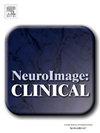Network analysis of structural MRI predicts executive function in paediatric traumatic brain injury
IF 3.4
2区 医学
Q2 NEUROIMAGING
引用次数: 0
Abstract
Intro
Paediatric traumatic brain injury (pTBI) is likely to result in cognitive impairment, specifically executive dysfunction. Evidence of the neuroanatomical correlates of this executive function (EF) impairment is derived from studies that treat morphometry of brain regions as distinct, independent features, rather than as a complex network of interrelationships. Morphometric similarity captures the meso-scale organisation of the cortex as the interrelatedness of multiple macro-architectural features and presents a novel tool with which to investigate the brain post pTBI.
Methods
In a retrospective sample (83 pTBI patients, 33 controls), we estimate morphometric similarity from structural MRI by correlating morphometric features between cortical regions. We compared the meso-scale organisation of the cortex between groups then, using partial least squares regression, assessed the predictive validity of morphometric similarity in understanding later executive functioning, two years post-injury.
Results
We found that patients and controls did not differ in terms of the overall magnitude of morphometric similarity. However, a pattern of ROI-level morphometric similarity was predictive of day-to-day EF difficulties reported by parents two years post-injury. This prediction was validated using a leave-one-out, and 20-fold cross-validation approach. Prediction was driven by regions of the prefrontal cortex, typically important for healthy maturation of EF skills in childhood. The meso-scale organisation of the cortex also produced more accurate predictions than any one morphometric feature (i.e. cortical thickness or folding index) alone.
Conclusion
We conclude that these methodologies show utility in predicting later executive functioning in this population.
结构性核磁共振成像网络分析可预测儿科创伤性脑损伤的执行功能
简介:小儿创伤性脑损伤(pTBI)很可能导致认知障碍,特别是执行功能障碍。有关这种执行功能(EF)障碍的神经解剖学相关证据来自于将大脑区域的形态测量视为不同的、独立的特征,而非相互关系的复杂网络的研究。形态测量相似性捕捉到了皮层的中尺度组织,即多个宏观结构特征之间的相互关系,并为研究 pTBI 后的大脑提供了一种新的工具。方法在一个回顾性样本(83 名 pTBI 患者,33 名对照组)中,我们通过关联皮层区域之间的形态测量特征,从结构 MRI 中估计形态测量相似性。我们比较了各组之间皮层的中尺度组织,然后使用偏最小二乘法回归评估了形态计量相似性在了解受伤两年后的执行功能方面的预测有效性。然而,ROI水平的形态计量相似性模式可预测受伤两年后父母所报告的日常执行功能困难。该预测采用了 "留一弃一 "和 20 倍交叉验证的方法进行了验证。预测由前额叶皮层区域驱动,而前额叶皮层区域通常对童年时期EF技能的健康成熟非常重要。皮层的中尺度组织也比任何一种形态特征(即皮层厚度或折叠指数)单独产生更准确的预测结果。
本文章由计算机程序翻译,如有差异,请以英文原文为准。
求助全文
约1分钟内获得全文
求助全文
来源期刊

Neuroimage-Clinical
NEUROIMAGING-
CiteScore
7.50
自引率
4.80%
发文量
368
审稿时长
52 days
期刊介绍:
NeuroImage: Clinical, a journal of diseases, disorders and syndromes involving the Nervous System, provides a vehicle for communicating important advances in the study of abnormal structure-function relationships of the human nervous system based on imaging.
The focus of NeuroImage: Clinical is on defining changes to the brain associated with primary neurologic and psychiatric diseases and disorders of the nervous system as well as behavioral syndromes and developmental conditions. The main criterion for judging papers is the extent of scientific advancement in the understanding of the pathophysiologic mechanisms of diseases and disorders, in identification of functional models that link clinical signs and symptoms with brain function and in the creation of image based tools applicable to a broad range of clinical needs including diagnosis, monitoring and tracking of illness, predicting therapeutic response and development of new treatments. Papers dealing with structure and function in animal models will also be considered if they reveal mechanisms that can be readily translated to human conditions.
 求助内容:
求助内容: 应助结果提醒方式:
应助结果提醒方式:


